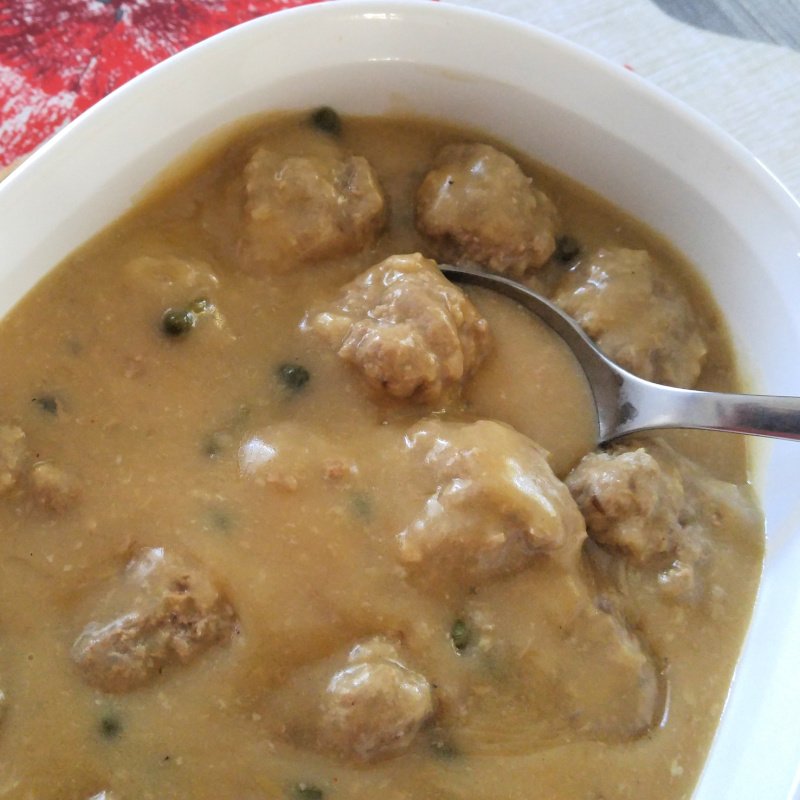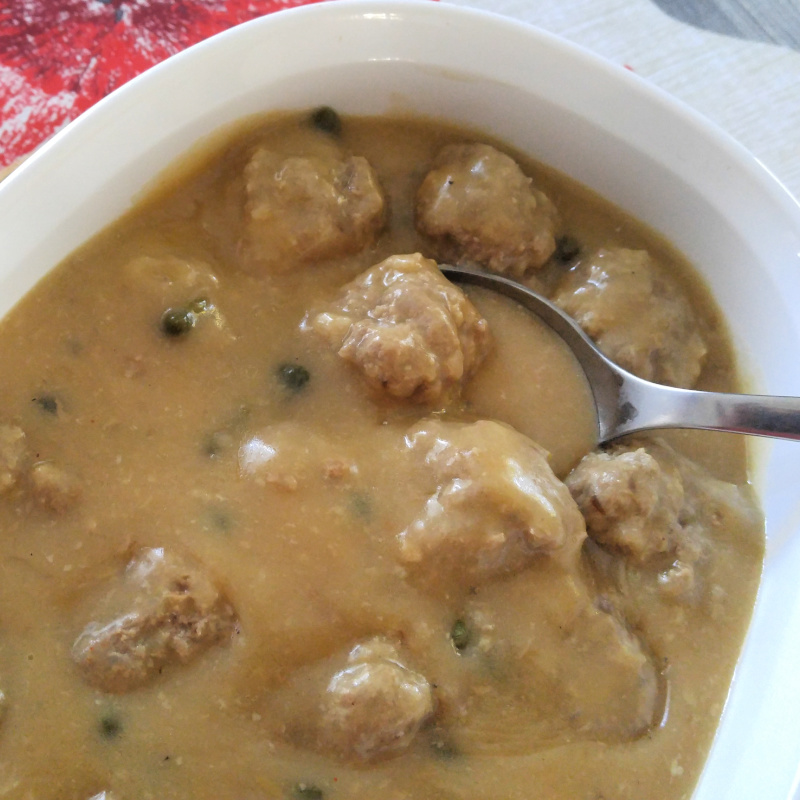- Home
- German Food Guide
- German Meatballs Recipe
German Meatballs Recipe & Sauce: Königsberger Klopse
By: Gerhild Fulson / Using her extensive experience and cultural knowledge, Oma Gerhild provides trusted, authentic, and easy-to-follow German recipes both here and in her many cookbooks.
Today, I'm sharing one of my all-time favorite dishes: Königsberger Klopse. This isn't just any meatball recipe, oh no. This is the time-honored classic German dish that takes me right back to my Mutti's kitchen.
A Taste of Tradition
Mutti (German for Mom) frequently made this for Sunday dinner as well as for special occasions. Mutti was from Berlin and these meatballs with their creamy, rich caper sauce are considered a regional Berliner dish. The melt-in-your-mouth tenderness of the meatballs, swimming in that velvety creamy sauce – lecker schmecker!
Mutti was a wonderful cook. Having left Germany in the 1950s and moving to Canada, it wasn't easy for her to reproduce her favorite dishes without access to local German ingredients. She experimented and tweaked her old handwritten recipes, and my two sisters and I grew up in Canada with German food in our blood!
Konigsberger Klopse was one such food. And, it was a favorite.
Picture this: delicate meatballs made from a blend of ground beef and pork, gently simmered in a luscious sauce that's tangy from capers and lemon, yet creamy from a generous dollop of sour cream. Yep, lecker schmecker!
A Dish with History
Königsberger Klopse originate from the city of Königsberg, once the capital of East Prussia. East Prussia was part of Germany from the formation of the German Empire until the end of World War II.
It ceased to be German territory after 1945 and was divided between Russia, Poland, and Lithuania, meaning that Königsberg, now known as Kaliningrad, is presently part of Russia. However, this dish remains a beloved part of German cuisine. It's a testament to how food can preserve cultural heritage.
But why did Königsberger Klopse become a Berliner regional dish, considering that the distance between East Prussia and Berlin is about 350 miles?
After World War II, when Germany lost its eastern territories, including East Prussia, many Germans from these areas were expelled or fled westward. In Berlin, which received many East Prussian refugees, these refugees brought their culinary traditions with them. Many of their dishes were adopted into the local cuisine. Thus, these meatballs became a regional dish for Berlin.
In a recent poll in Germany, this classic Berliner dish is now considered one of the most popular dishes throughout all of Germany! That means, it's the one dish that is known not just in Berlin but can be found in homes and restaurants anywhere in Germany. Now that's a testament to the deliciousness of this East Prussian classic German meal.
German meatballs vs Swedish meatballs
You might be wondering, “Are these similar to Swedish meatballs?” While there are similarities (both are comfort foods, after all), our German ones have their own unique twist.
Interestingly, most German sauces are brown (pork, beef, etc.), but this is a white sauce, an anomaly in Germany. The capers and lemon in the sauce give the German meatballs, the Königsberger Klopse, a distinctive tangy flavor that sets them apart. Yes, totally different from those Swedish meatballs!
Because this is a white sauce, Mutti actually called the dish, Königsberger Klopse mit Hollandische Sosse, meaning they were in a Hollandaise sauce. And that's what I grew up thinking a Hollandaise sauce was.
Once I started researching for my recipe website, I realized her mistake. However, in my mind, I still think about this, Mutti's recipe, as Ja, mit Hollandische Sosse! LOL.
(I've since developed my own easy Hollandaise sauce, that's so good on white asparagus. A real treat. So totally different from what I THOUGHT Hollandaise was.)
Cooking Methods and Ingredients
Now, I'll let you in on a little secret – I tried other German meatball recipes, but couldn't quite make them taste like my Mutti's. Her great recipe, with its caper-y cream sauce, was, oh, so, good!
And yes, you can omit those capers if you really don't like them. I recall that when I was really young, I'd work my way around those funny little 'balls'. I don't know why, but I thought they were some kind of seafood. Sometimes Mutti didn't add them when they weren't available, and the sauce was still so yummy. Other times, I'd just pick them out. Now, though, I think it's a shame to not use them.
I've tweaked her recipe a bit to make it just a tad easier and quicker. Instead of cooking the meatballs separately (which is traditional) and draining away that meatball broth, I simmer them right in the sauce. It saves time and actually infuses the meatballs with even more flavor.
When it comes to the meat, traditionalists insist on using ground veal, but I find a mix of beef and pork works beautifully. Don't worry if you're not a fan of anchovies – they're optional in this recipe, as well as those capers. Both add a subtle depth of flavor, but the dish is still delicious without them.
Serving Suggestions
Wondering what to serve with Königsberger Klopse? In true German style, boiled potatoes are a must. They're perfect for soaking up that irresistible sauce. Add some tender beets on the side (adds a nice bit of color), and you've got yourself a meal that would make any German Oma proud.
Mashed potatoes are delicious with this as well. And, since I don't mind being non-traditional, I find almost any veggie will work. Below, I'm serving them with peas. Still lecker.
 Traditional Königsberger Klopse mit Sosse — served non-traditionally with peas and no capers in the sauce
Traditional Königsberger Klopse mit Sosse — served non-traditionally with peas and no capers in the sauceAnd if you're feeling extra festive, why not pair it with a white wine, such as a crisp German Riesling?
Got leftovers? You're blessed! These leftover meatballs taste even better the next day. Store them in a sealed container in the fridge for 1-2 days. To reheat, gently warm them on the stove top, adding a little broth if the sauce has thickened too much.
Ready to Make this German Meatballs Recipe?
There you have it – a true taste of Germany (and Berlin) right in your own kitchen! These Königsberger Klopse are more than just a meal. They're a warm hug from Oma, a trip down memory lane, and a celebration of German culinary tradition all rolled into one delicious dish.
So, what are you waiting for? Gather your ingredients, put on your favorite apron, and let's bring a little bit of Deutschland to your dinner table. Guten Appetit!
German Meatballs Recipe & Sauce: Königsberger Klopse
Oma's German meatballs recipe with a twist! Traditional Königsberger Klopse made simple. Impress your family with this creamy, tangy dish from East Prussia.
Prep Time20 minutes |
Cook Time25 minutes |
Total Time45 minutes |
Servings:
Makes 4 - 6 servings
Ingredients:
For the Meatballs:
- 1 stale Kaiser roll, sliced
- 1 cup (240 ml) lukewarm water
- 1 tbsp (14 g) butter
- 2 small shallots, finely diced
- 2 tbsp (8 g) chopped fresh parsley
- 1 lb (454 g) lean ground beef
- 1 lb (454 g) lean ground pork
- 2 large eggs
- 1½ tbsp (23 g) German mustard
- 3 finely diced anchovies (optional)
- 1½ tsp (9 g) salt
- ½ tsp (1 g) freshly ground black pepper
- ¼ tsp (0.5 g) paprika
For the Sauce:
- 6 tbsp (84 g) butter
- 6 tbsp (48 g) all-purpose flour
- 6 cups (1.4 l) hot beef stock or broth
- 1 bay leaf
- Salt and freshly ground white pepper, to taste
- 2 - 3 tbsp (30 - 45 ml) lemon juice
- ¾ cup (180 g) sour cream
- 2 tbsp (16 g) capers (optional)
- Pinch of sugar
- Freshly ground nutmeg, to taste
Instructions:
For the Meatballs:
- Place the sliced Kaiser roll in a small bowl and add the lukewarm water. Let it sit for about 10 minutes. This will make your meatballs extra tender.
- While the bread is soaking, melt the butter in a small frying pan and sauté the shallots until they're soft and translucent – about 2 minutes. Toss in the parsley and give it another minute in the pan. Set this mixture aside to cool.
- Give the soaked roll a good squeeze to remove the excess water, then crumble it into a large bowl.
- Add all the remaining meatball ingredients to the bowl, including the cooled shallot and parsley mixture. Gently mix everything together with your hands.
- Shape the meat mixture into 1½-inch meatballs. You should get around 24 meatballs. Place on a plate, cover, and place in the fridge until ready to use.
For the Sauce:
- In a large skillet over medium heat, melt the butter. Whisk in the flour until smooth, but do not let it brown.
- Gradually whisk in the hot beef broth. Keep whisking until the sauce is smooth and lump-free. Add the bay leaf and let it simmer for about 5 minutes. Season with salt and pepper to taste.
- Gently place the meatballs into the sauce and bring it to a simmer. Lower the temperature to a medium-low heat, cover, and let it simmer gently for 15 minutes. Give it an occasional stir to make sure nothing sticks to the bottom.
- Once the meatballs are cooked through, use a slotted spoon to transfer them to a serving bowl. Cover to keep warm.
- Remove the bay leaf. Stir in 2 tablespoons of lemon juice, the sour cream, and capers (if using). Season with a pinch of sugar and some freshly grated nutmeg. Taste and add more salt, pepper, or lemon juice, if needed. The sauce should be tangy and creamy.
- Pour the sauce over your meatballs and serve!
Notes/Hints:
- Can’t find German mustard? Just use your favorite sharp and non-grainy variety.
- No Kaiser roll? Any day-old rolls or stale white bread will do in a pinch. Don't have that, either? Then bread crumbs can be used.
- If you're not a fan of capers, try chopped pickles instead for that tangy kick.
- I've seen some recipes that include a splash of Worcestershire sauce. Not my thing, but maybe yours? Other recipes include ground caraway seeds.
- Make a double batch and freeze half in a freezer-safe container for a quick weeknight dinner. Just thaw and reheat gently.
- Next time you make these, instead of using a mix of ground meats, try ground veal and see how they compare.
* * * * *
Unless otherwise noted recipe, images and content © Just like Oma | tourmygermany.com
German Meatballs Recipe & Sauce: Königsberger Klopse
By Oma Gerhild Fulson
Oma's German meatballs recipe with a twist! Traditional Königsberger Klopse made simple. Impress your family with this creamy, tangy dish from East Prussia.
Ingredients: Kaiser roll, butter, shallots, parsley, ground beef, ground pork, eggs, mustard, salt, black pepper, paprika, flour, beef stock, bay leaf, lemon juice, sour cream, nutmeg
For the full recipe, scroll up ...








